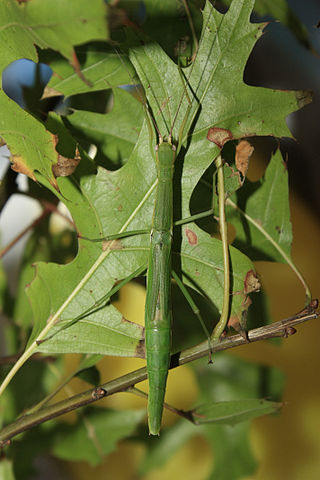
Robert Walter Campbell Shelford, was a British entomologist and museum administrator and naturalist, with a special interest in entomology and insect mimicry; he specialised in cockroaches and also did some significant work on stick insects.

The Phasmatidae are a family of the stick insects. They belong to the superfamily Anareolatae of suborder Verophasmatodea.

Phobaeticus is a genus of Asian stick insects comprising over 25 species. The genus includes some of the world's longest insects.
Asceles is a genus of stick insects in the tribe Necrosciini. Some of the species of Asceles have a distribution in Malaysia and Singapore.

Sceptrophasma hispidulum, commonly known as the Andaman Islands stick insect, is a species of the stick insect family. It originates from the Andaman Islands and is commonly found in tropical forests there. They eat a variety of foliage, though in captivity they commonly eat blackberry bramble, hawthorn, oak, rose, and lettuce. The species has the Phasmid Study Group number PSG183.
Canuleius is a genus of walkingsticks in the family Heteronemiidae. There are at least 20 described species in Canuleius.

Cryptophyllium westwoodii is a species of leaf insect in the family Phylliidae. It is distributed from southern China, the Andaman islands, Myanmar, Indo-China, Sumatra and the Riouw Archipelago.

Paramenexenus is a genus of Asian stick insects belonging to the family Lonchodidae, erected by Josef Redtenbacher in 1908.

Heteropterygini is the only tribe within the subfamily of the Heteropteryginae. With 19 representatives described, this subfamily includes the fewest species of the three subfamilies, but includes the largest and most striking species of the family.

The Obrimini are the most species-rich tribe of the Phasmatodea family of the Heteropterygidae native to Southeast Asia.
Tirachoidea westwoodii is a species of stick insect in the order Phasmatodea. It is endemic to India, Myanmar, Thailand and Vietnam. The eggs of the stick insect are spheric, ca. 5 mm in length and have a three-lobed micropylar plate. The chorion of the eggs are hard to cut and consist of the three layers mineralized with calcium carbonate and calcium oxalate.

Heterocopus is a monotypic stick insect genus, containing Heterocopus leprosus as the only valid species.
Pterulina is a genus of stick insects in the tribe Clitumnini, erected by Bresseel & Constant in 2020. To date, species have been recorded from Vietnam only.
Metentoria is a genus of stick insects in the tribe Clitumnini, erected by Carl Brunner von Wattenwyl in 1907. Species have been recorded from: India and Vietnam.
Prosentoria is a genus of stick insects in the tribe Clitumnini, erected by Carl Brunner von Wattenwyl in 1907. Species have been recorded from: Vietnam and Borneo.

Micadina is a genus of stick insects in the tribe Necrosciini, erected by Josef Redtenbacher in 1908. Species have been recorded from temperate and subtropical Asia, including China, Japan, Korea and Vietnam.
Pachyscia is a genus of Asian stick insects in the tribe Necrosciini, erected by Josef Redtenbacher in 1908. Species have been recorded from Vietnam and China.

Josef Redtenbacher was an Austrian entomologist and teacher. He specialized in the orders of Orthoptera, Phasmatodea, Mantodea (mantis) and Blattodea (cockroaches), which are classically summarized as Orthoptera, as well as in the earwigs (Dermaptera), which are not assigned to the Orthoptera, especially from Austria-Hungary and Germany.

Tisamenus ranarius is a stick insect species (Phasmatodea), in the family of the Heteropterygidae native to the Philippines.

Obrimus mesoplatus is a stick insect species from the family of the Heteropterygidae native to the Philippine island of Luzon.











